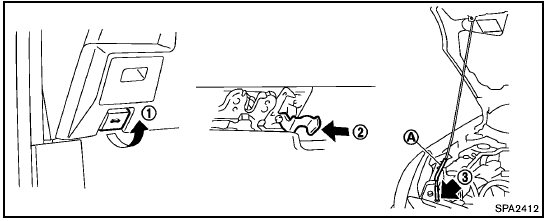 Nissan Rogue: Hood
Nissan Rogue: Hood

- Make sure the hood is completely closed and latched before driving.
Failure to do so could cause the hood to fly open and result in an accident.
- If you see steam or smoke coming from the engine compartment, to avoid injury do not open the hood.

When opening the hood:
1. Pull the hood release handle 1 located
below the instrument panel; the hood will
then spring up slightly.
2. Pull the lever 2 up at the front of the hood with your fingertips.
3. Raise the hood.
4. Remove the support rod from the hood and insert it into the slot 3 .
Hold the coated part A when removing or resetting the support rod. Avoid direct contact with the metal parts, as they may be hot immediately after the engine has been stopped.
When closing the hood:
1. Return the support rod to its original
position.
2. Slowly move the hood down to latch the lock.
3. Push the hood down to lock the hood securely into place.
 Setting hazard indicator and horn mode
Setting hazard indicator and horn mode
This vehicle is set in hazard indicator and horn
mode when you first receive the vehicle.
In hazard indicator and horn mode, when the
LOCK button 1 is pushed, the
hazard
indicator flashes tw ...
 Lift gate
Lift gate
- Always be sure the lift gate has
been closed securely to prevent it
from opening while driving.
- Do not drive with the lift gate open.
This could allow dangerous exhaust
gases to be dra ...
See also:
Arming the System
To arm the system, do one of the following:
○ Press on the RKE transmitter.
○ Lock the vehicle using the key in the driver door.
The alarm automatically arms after about 30 seconds. Th ...
Finish Damage
Quickly repair minor chips and scratches with touch-up materials available from
your dealer to avoid corrosion. Larger areas of finish damage can be corrected in
your dealer's body and paint s ...
Folding the rear seat backrest back
: Backrest
; Lock verification indicator
= Backrest release handle
Move the driver's or front-passenger seat forward if necessary.
Make sure that the seat belt does not become ...
